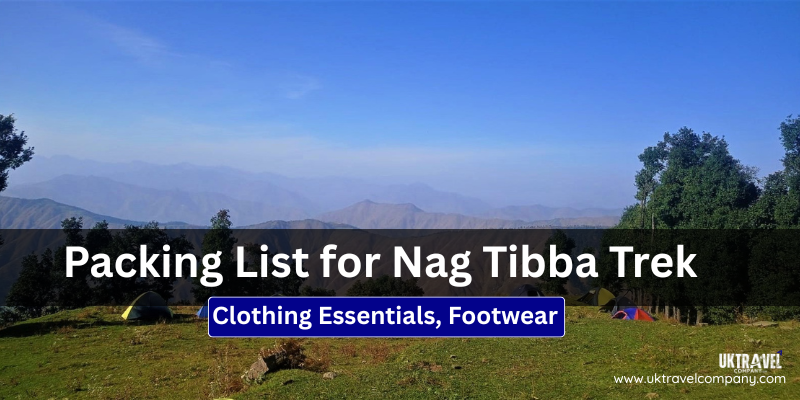Why Packing Right Matters
Packing smartly for the Nag Tibba Trek can make the difference between a comfortable journey and a challenging one. The trek may seem short (2 days on average), but the changing Himalayan weather demands preparedness. Carrying the right clothing, gear, and personal essentials ensures warmth, safety, and an enjoyable trekking experience —especially when temperatures can drop quickly in the evenings.
Clothing Essentials
Base Layers
- Lightweight thermal tops and bottoms (especially for winter)
- Moisture-wicking fabrics like merino wool or polyester
Insulating Layers
- Fleece jacket or light down jacket for warmth
- Woolen sweater or pullover (optional for cold months)
Outer Shell / Jacket
- Windproof and waterproof jacket (with hood)
- Breathable rain shell during monsoon
Trek Pants
- 2 pairs of quick-dry trekking pants
- 1 comfortable pair for the campsite
- Avoid jeans — they’re heavy and slow to dry
Socks, Caps & Gloves
- 3–4 pairs of trekking socks (wool or synthetic)
- 1 pair of warm woolen socks for the night
- Woolen cap/beanie, sun cap, and gloves (fleece/waterproof depending on season)
Footwear
Trekking Shoes
- Mid-ankle waterproof trekking shoes with good grip
- Break them in before the trek to avoid blisters
Extra Footwear
- Lightweight sandals or flip-flops for camp use
- Helps your feet relax after a day’s hike
Backpack Essentials
Personal Items
- Government ID Proof (mandatory for forest registration)
- Cash (limited ATMs beyond Dehradun)
- Permits or Booking Slips from trek operator
- Toiletries: Toothbrush, toothpaste, biodegradable soap, wet wipes, tissue paper
- Sunscreen (SPF 40+), Lip Balm, Moisturizer to prevent sun and windburn
- Sunglasses, Hat, Bandana or Scarf for sun protection
Trekking Gear
- Trekking Poles: Reduces knee strain, especially on descent
- Headlamp or Torch: Essential for campsite or night movement
- Power Bank: 10,000 mAh or more (no charging facilities on trek)
- Water Bottles or Hydration Pack: Carry at least 2L of water capacity
First Aid & Medicines
- Basic First Aid Kit: Bandages, antiseptic cream, cotton, crepe bandage, ORS
- Common Medicines: For headache, stomach upset, cold, fever, pain relief
- AMS Safety Items: Although Nag Tibba is moderate in altitude (~3,022m), carry
Diamox if sensitive to elevation changes - Personal Prescriptions: Any regular medications as advised by your doctor
Snacks & Energy Boosters
- Dry fruits (almonds, raisins, cashews)
- Energy bars and protein bars
- Chocolates for quick sugar boost
- Electrolyte sachets (Glucon D, ORS) to stay hydrated
Optional Items
- Camera or GoPro for capturing stunning views
- Travel journal or notebook
- Binoculars for bird watching
- Small combination lock for your backpack
- Portable charger or solar charger
Season-Wise Packing Tips
Winter Trek Essentials (Dec–Feb
- Heavy down jacket, thermal layers, wool gloves, warm cap
- Snow gaiters or microspikes (if trail is icy)
- Hot water bottle (optional for comfort)
Summer Trek Essentials (Apr–Jun)
- Lightweight clothing, sun hat, sunscreen, hydration salts
- Light fleece for cool evenings
- Sunglasses with UV protection
Monsoon Trek Essentials (Jul–Sep)
- Waterproof poncho or rain jacket
- Quick-dry clothes and anti-slip trekking shoes
- Plastic zip pouches for documents and electronics
Eco-Friendly Packing Tips
Respect the Himalayas – Leave No Trace!
- Avoid single-use plastics like disposable bottles or wrappers
- Carry reusable water bottles and cutlery
- Bring back all non-biodegradable waste
- Choose eco-friendly toiletries (biodegradable soap/shampoo)
- Pack light and mindfully — every gram counts on the mountain
Book Your Nag Tibba Trek Package
Plan Your Nag Tibba Trek with UK Travel Company
Experience a seamless, eco-friendly, and guided adventure with expert trek leaders and
local support.
Book Now
Includes accommodation, meals, guide, permits, and transportation options.
FAQs About Packing for Nag Tibba Trek
What kind of shoes are best for Nag Tibba Trek?
Waterproof, high-ankle trekking shoes with good grip. Avoid sneakers.
Do I need thermals for the Nag Tibba Trek?
Yes, during winter (Dec–Feb) you’ll need thermals; not essential in summer.
Can I rent trekking gear in Dehradun?
Yes, basic gear like trekking poles, jackets, and shoes are available on rent.
How many pairs of clothes should I carry?
Two trekking outfits and one for the campsite are enough for the short trek.
Should I pack rain gear even in winter?
Yes, always carry a rain cover or poncho — weather in Himalayas can change suddenly.
Are power banks allowed on the trek?
Yes, essential since no charging points exist after Dehradun.
Is a sleeping bag required?
Most trek operators provide sleeping bags, but you can carry a liner for hygiene.
What’s the total backpack weight ideal for Nag Tibba?
Keep it around 8–10 kg max to ensure comfort during ascent.
Final Words
Packing right is the first step toward an unforgettable Nag Tibba experience. From proper footwear to weather-proof layers and eco-conscious gear, every item counts when you’re trekking in the Himalayas.
So, pack light, stay prepared, and step into the adventure confidently. Plan your Nag Tibba Trek with UK Travel Company for a well-organized, safe, and memorable experience.



